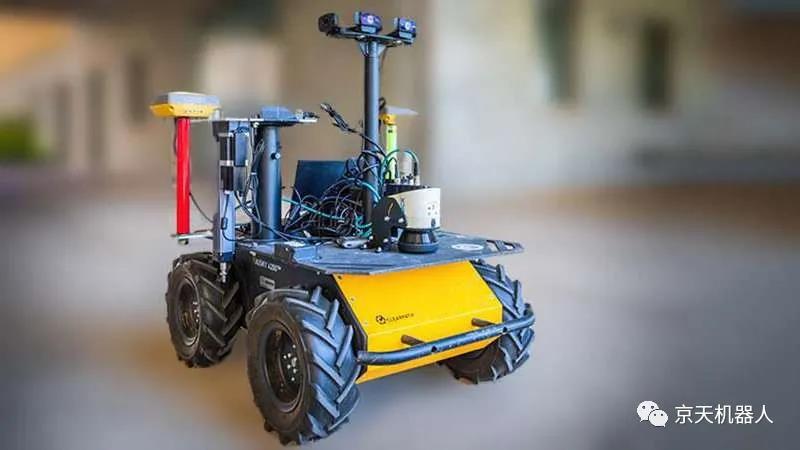
The basic robot that researchers are developing for a new plant moisture measurement system will navigate rows of crops to reach individual leaves and stems.
Every gardener knows how difficult it is to judge when to water plants. If you multiply this by tens or hundreds of acres, it is easy to understand the challenges that growers face in maintaining crop health and managing water resources efficiently and intelligently.
To accurately determine the water demand, growers manually remove individual leaves from the plant, place them in a pressure chamber, and then apply air pressure to see when water leaks from the leaf stems. This type of testing is very time-consuming, which means that growers can only reach multiple areas of a field each day, and cannot test as often as needed to accurately determine the best irrigation plan mode.
A group of researchers from the University of California Riverside and the University of California Merced have received more than $1 million in grants from the US Department of Agriculture through the National Robotics Program of the National Science Foundation to address these challenges. Assistant Professor Konstantinos Karydis and Professor Amit K. Roy-Chowdhury of the Department of Electrical and Computer Engineering at the University of California, Riverside. UC Merced responsible for this work is represented by Stefano Carpin, a professor of computer science. And Joshua Viers, professor of environmental engineering.
As part of the project, the team is developing a robotic pressure chamber that can automatically sample blades and immediately test them on site to provide the latest data. The system can even collect a wide range of data over a period of time instead of just providing snapshots.
Frequently updated data can help growers better plan irrigation plans to save water, optimize the time and energy of crop experts responsible for determining and analyzing water shortages, and help reduce certain costs in the food production chain.
Current measurement techniques involve collecting blade samples and transporting them to remote locations, where testers can use very precise and expensive pressure chambers. Or use a hand-held pressure chamber to take and analyze leaf samples in the field.
"In the first category, leaf samples may be mixed together, making it impossible to trace them to a specific area of their origin," Karydis said. "In addition, the characteristics of the blade may change over time. Sampling and analysis may produce misleading results."
The accuracy of handheld instruments in the field may be low, but different leaves of the same plant can be used for multiple tests. This method is time-consuming and labor-intensive, and must be carried out by specially trained personnel.
Carpin has collaborated with colleagues at UC Davis and UC Berkeley to create a Robot-Assisted Precision Irrigation Delivery System (RAPID), which travels along a row of crops and adjusts the irrigation flow based on sensor data to accurately tell the robot the needs of each plant. .
The project will use the same mobile base robot as in RAPID, but it will be equipped with a custom robot blade sampler and pressure chamber designed by researchers at UC Riverside, and will be combined with an unmanned robot that can conduct field surveys and guide it. Machine matching interest range.
Carpin said: "Using this process, growers can investigate plants all day, even in large fields."
This four-year project will provide summer research opportunities for graduate and undergraduate students. The project is divided into four phases: the development of the conference hall; the development of machine vision so that the robot can "see" the water from the leaf stems; and the coordination and evaluation of multiple robots in the air and on the ground.
The researchers plan to build the first prototype of the automatic pressure chamber before the spring of 2021, evaluate its performance and improve the design in a controlled environment in the spring and summer of 2021. They hope to complete the installation before the winter of 2022 so that they can Start a controlled field test.
Carpin said: "We must act quickly, because if we miss a peak period of growth, then we have to wait another nine months." "We hope to be able to start the test next summer, and test every summer And we need to be able to maximize testing."
The researchers wrote in their recommendations that after all the components are designed, these designs and codes will become open source, and all data collected during the project will be made available to the scientific community.
The project was conducted after Carpin and Viers, head of the UC Merced Center for Information Technology Research (CITRIS), discussed the challenges of growing almonds and grapes with California farmers. Karydis and Roy-Chowdhury have been hearing about the same challenges faced by citrus and avocado growers in the Riverside area, so the four have formed a partnership.
Carpin said: "California agriculture poses a challenge in terms of scalability." "But this is an exciting collaboration because we will develop a system that can work on different crops."
For information about HUSKY, please visit our clearpath Chinese website:
http://www.clearpathcn.com/product.php?aid=39

Donghu Robot Laboratory, 2nd Floor, Baogu Innovation and Entrepreneurship Center,Wuhan City,Hubei Province,China
Tel:027-87522899,027-87522877
Robot System Integration
Artificial Intelligence Robots
Mobile Robot
Collaborative Robotic Arm
ROS modular robot
Servo and sensor accessories
Scientific Research
Professional Co Construction
Training Center
Academic Conference
Experimental instruction
Jingtian Cup Event